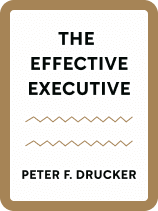

This article is an excerpt from the Shortform book guide to "The Effective Executive" by Peter F. Drucker. Shortform has the world's best summaries and analyses of books you should be reading.
Like this article? Sign up for a free trial here .
What are three to five time-wasting activities that affect your day-to-day work? Can you think of ways to reduce the amount of time you spend on them?
Wasting time on things that don’t produce results is unfortunate but unavoidable. In his book The Effective Executive, management consultant Peter Drucker offers four-step advice on how to minimize time-wasting activities and free up time for tasks that yield real, tangible results.
Follow these four steps to root out your time-wasters.
Peter Drucker: Cut Your Time-Wasters
1) Identify and eliminate time-wasting activities that don’t produce results, including things that don’t need to be done in the first place. For each item on your time record, ask yourself what would happen if you hadn’t done it or don’t do it going forward. If the answer is nothing, stop doing it. Drucker claims that most executives could eliminate about 25% of their activities without anyone noticing; he cites speeches, social events, committee memberships, directorships, and lunch or dinner events as often unnecessary.
| Should We Cut the Activities Drucker Recommends? Today, the activities Drucker suggests cutting might be considered an essential part of branding, marketing, or networking. A way to evaluate these activities and decide if they’re useful enough to continue is to borrow the lean manufacturing idea of determining which ones are value-added versus non-value-added: Value-added activities add customer value to a business process, product, or service. This aligns with Drucker’s advice to say “no” to doing anything that doesn’t help your organization or enhance your contribution to the organization’s performance. Similarly, in Eat That Frog, Brian Tracy writes that you should creatively procrastinate or put off, eliminate, or delegate activities that don’t add value to your work. Also, he says you should keep reviewing your activities for time wasters, looking especially hard at major time consumers. |
2) Determine which activities could be done just as well or better by someone else, and delegate them. While some people view delegating as being lazy or taking advantage of a subordinate, Drucker emphasizes that as an executive, you’re being paid for your unique contribution to the organization’s performance—and when you allow yourself to be distracted from this by tasks someone else can do, you undercut your effectiveness as well as the organization’s.
| How to Delegate Effectively In High Output Management, CEO Andrew Grove identifies the following requirements for effective delegating:You and the person you’re delegating to need to have the same information and agree on how to do the task.You can keep the tasks you like doing as long as you’re fully aware of your motivations for not delegating them.You monitor the person you’re delegating to.You delegate tasks you’re familiar with, because it’s easier to monitor things you already know how to do.If you’re delegating decision-making, monitor the decision-making process. |
3) Identify the ways in which you waste others’ time (and therefore your own). Drucker advises asking your employees and colleagues what you do that wastes their time (that doesn’t increase their effectiveness or contribution).
You may be doing something that’s productive for you but that still wastes others’ time—for example, requiring an employee to track weekly data and produce a report that you occasionally refer to but that isn’t useful to the employee creating it.
4) Cut time-wasters resulting from poor management. Drucker identifies several types of time-wasters resulting from poor management. They’re under your control and are therefore fixable:
Wasted time resulting from lack of planning. An example is the recurring crisis—for instance, the annual audit—which suddenly requires everyone’s full attention because it was left until the last minute. A recurring crisis around a regular event can be foreseen and prevented by creating a routine that administrative workers can handle. (Shortform note: Management by crisis—not the same thing as crisis management—has many downsides. The biggest is that a preoccupation with putting out fires keeps you in fight-or-flight mode, blocking the higher-order thinking needed for problem-solving. Also, it prevents you from troubleshooting future problems, planning, or communicating effectively.)
Wasted time resulting from mishandled information. Examples include:
- Information doesn’t get to the people who need it, when they need it. For instance, a production manager may neglect to inform a sales rep that equipment problems will delay fulfillment of an order—and the rep may be blindsided by a call from an angry client upset about the missed delivery deadline. (Shortform note: One antidote to the problem of information not getting to those who need it is a company-wide policy of transparency.)
- Information isn’t in a useful form. Managers who don’t get useful numbers may spend time tracking numbers and creating their own reports. (A 2018 Inc. article estimated that 73% of company data isn’t applied because it’s not in a workable form.)
- (Shortform note: An even bigger problem with mishandling information today is that it gets to the wrong people due through data breaches. This wastes enormous time and money fixing the problems and closing loopholes, and of course it squanders goodwill and credibility with clients and customers, for whom it can cause massive problems. Common causes of breaches include malware, improper employee actions including theft, and human error.)
Wasted time resulting from too many meetings. Drucker contends that one of the worst things about poor organization is that it spawns an excessive number of meetings, which keeps executives and others from getting important work done. (Shortform note: A 2017 HBR article noted that executives spend about 23 hours a week in meetings, up from 10 hours in the 1960s. Other surveys and estimates range much higher. The article points out that many meetings not only waste time but also interrupt deep work.)
Drucker says meetings should comprise no more than a quarter of an organization’s time—and if executives spend more than that in meetings, there’s a structural problem:
- A job is being spread among too many people; responsibility is unclear, or information is being shared with too many people, rather than targeted to those who need it. (Shortform note: Vague job responsibilities not only waste time, but they also cause employees stress and undermine productivity.)
- The organization’s strategy may be unclear, resulting in people doing overlapping work, or unimportant work.
- (Shortform note: An Inc. article suggests additional reasons for excessive meetings, including managers showing dominance, teams delaying work or a decision, or people protecting or trying to expand their turf.)
Drucker says meetings should be the exception rather than the rule. They are sometimes needed—people have to cooperate by sharing knowledge and information to get a specific task done. But to avoid wasting time, meetings should be purposeful and focused. In his discussion of practice #3, Drucker argues that your meetings should be focused specifically on enhancing your contribution to the organization; we’ll discuss this in detail later.
| Design an Agenda for an Effective Meeting The key to an effective, focused meeting is arguably having a well-planned and designed agenda. In the Harvard Business Review, Roger Schwarz discusses the steps for designing an effective agenda, including:Solicit topics from your team and decide which to include in the meeting.Determine the goal of discussing each topic you include.Structure the discussion of each topic (time limit, discussion leader, how a decision (if any) will be made.Share the agenda with participants so they can prepare.Conduct the meeting by following the agenda.Debrief at the end of the meeting on what could have gone better. Read our summary of the article to see our customized agenda template for an effective meeting. Countless other articles and books discuss how to hold meetings. To cite just a few:In Traction, Gino Wickman discusses two types of necessary leadership meetings (annual and weekly), and he lists specific items that should be on the agenda for each.In High Output Management, Andrew Grove differentiates between process-oriented and mission-oriented meetings, and he gives tips for conducting both.In Death by Meeting, Patrick Lencioni cites three meeting shortcomings and how to fix them: lack of drama (they’re boring), lack of structure, and infrequency. |

———End of Preview———
Like what you just read? Read the rest of the world's best book summary and analysis of Peter F. Drucker's "The Effective Executive" at Shortform .
Here's what you'll find in our full The Effective Executive summary :
- How to manage yourself before you can manage others
- The five practices that anyone can learn to be more effective
- Why leaders should purposely create disagreements






